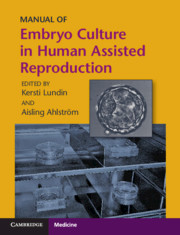Book contents
- Manual of Embryo Culture in Human Assisted Reproduction
- Cambridge Laboratory Manuals in Assisted Reproductive Technology
- Manual of Embryo Culture in Human Assisted Reproduction
- Copyright page
- Contents
- Contributors
- Preface
- Chapter 1 Facilities for Embryo Culture
- Chapter 2 Incubators for Embryo Culture
- Chapter 3 Consumables for the IVF Laboratory
- Chapter 4 Embryo Metabolism and What Does the Embryo Need?
- Chapter 5 Culture Media and Embryo Culture
- Chapter 6 Optimal Handling Techniques for Culture of Human Embryos
- Chapter 7 From Identification to Witnessing
- Chapter 8 Timing of Embryo Culture
- Chapter 9 Time-Lapse Technology
- Chapter 10 Laboratory Monitoring for Embryo Culture
- Chapter 11 Embryo Culture and IVF Offspring Outcome
- Chapter 12 The Changing Culture of Embryo Culture
- Index
- Plate Section (PDF Only)
- References
Chapter 6 - Optimal Handling Techniques for Culture of Human Embryos
Published online by Cambridge University Press: 15 April 2021
- Manual of Embryo Culture in Human Assisted Reproduction
- Cambridge Laboratory Manuals in Assisted Reproductive Technology
- Manual of Embryo Culture in Human Assisted Reproduction
- Copyright page
- Contents
- Contributors
- Preface
- Chapter 1 Facilities for Embryo Culture
- Chapter 2 Incubators for Embryo Culture
- Chapter 3 Consumables for the IVF Laboratory
- Chapter 4 Embryo Metabolism and What Does the Embryo Need?
- Chapter 5 Culture Media and Embryo Culture
- Chapter 6 Optimal Handling Techniques for Culture of Human Embryos
- Chapter 7 From Identification to Witnessing
- Chapter 8 Timing of Embryo Culture
- Chapter 9 Time-Lapse Technology
- Chapter 10 Laboratory Monitoring for Embryo Culture
- Chapter 11 Embryo Culture and IVF Offspring Outcome
- Chapter 12 The Changing Culture of Embryo Culture
- Index
- Plate Section (PDF Only)
- References
Summary
The purpose of this chapter is to review some of the factors that influence laboratory and clinical outcomes, broadly under the heading of optimal handling techniques. Two principal environments are encountered – inside and outside the incubator. The chapter will address media buffers, gas atmosphere, timing and setting up culture or holding vessels, protection of medium performance, temperature relative to handling gametes and embryos, lighting, pH, incubation choices, and workflow. The importance of the interplay between these variables cannot be overlooked.
- Type
- Chapter
- Information
- Manual of Embryo Culture in Human Assisted Reproduction , pp. 53 - 60Publisher: Cambridge University PressPrint publication year: 2021



